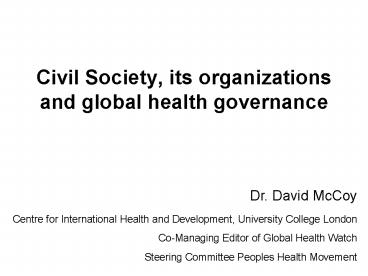Civil Society, its organizations and global health governance - PowerPoint PPT Presentation
1 / 19
Title: Civil Society, its organizations and global health governance
1
Civil Society, its organizations and global
health governance
Dr. David McCoy Centre for International Health
and Development, University College
London Co-Managing Editor of Global Health
Watch Steering Committee Peoples Health Movement
2
Global Health Governance
- Loosely defined as the structures, systems, rules
and processes at the global level for - making decisions about health-policy and
priority-setting - financing and implementing global health
initiatives, programmes and plans - ensuring appropriate and effective systems of
accountability.
3
The rise of the CSO
- First registered international NGO - the
Anti-Slavery Society -formed in 1839 - Number of international NGOs grew from about
1,000 in 1914 to about 37,000 in 2000 - Clear evidence exists of their impact
- Alma Ata
- International Code
- FCTC
- Landmines
- Doha Declaration
- AIDS treatment
4
What do we mean by civil society organisations
and how do they relate to each other and to other
actors?
- CSOs are usually described in terms of a
framework of three distinct sectors - Some UN bodies describe businesses as being
non-governmental
Government
Civil society
Business
5
Types of CSO
- NGOs
- Community based organisations
- Universities
- Think-tanks
- Professional associations and trade unions
- Private foundations
- Social movements
- Patient groups
6
GONGOs
Government
Civil society
PINGOs
Business
BONGOs
7
IGOs
Foundations
GHPs
Civil society
G8, OECD
Business
8
Differences within civil society
- By funding source and relationship to other
actors - By size
- By geography and wealth
- According to their legitimacy
- According to what they do
- According to their politics, views and
orientation
9
CSOs by politics and orientation
- PHC orientation
- Proximal or Distal determinants
- Scholte 1999
- Conform
- Reform
- Transform
10
How CSOs engage in GHG
- working within GHG institutions
11
- Through formally constituted advisory or
technical committees or by being incorporated
into decision-making structures - In one overview of 23 GHPs, out of a total of 298
Board seats, 23 per cent and five per cent were
occupied by academic and NGO representatives
respectively - The Global Fund has three seats allocated to NGOs
amongst its twenty voting members on its Board of
Governors (one for a developed country NGO one
for a developing country NGO and one for
communities affected by the diseases). - But 23 of governing board seats were occupied by
the private (corporate) sector
12
How CSOs engage with or participate in GHG
- working within GHG institutions
- lobbying and campaigning from the outside
- playing a watchdog role
- working with or through other actors
- opposing and resisting
13
C6 Oil extraction and health in the Niger Delta
14
(No Transcript)
15
(No Transcript)
16
(No Transcript)
17
The struggle of indigenous peoples to hang on to
their lands and cultures
18
The successful struggle against water
privatisation in Cochabamba (Bolivia) followed
days of street protests and police retaliation
19
Conclusion
- A complex and complicated issue
- Is there good enough accountability?
- Is there enough transparency? Who is being
co-opted by whom? - Is there a fair hearing of all voices?
- Do we need more independent funding































